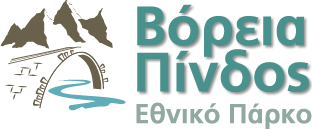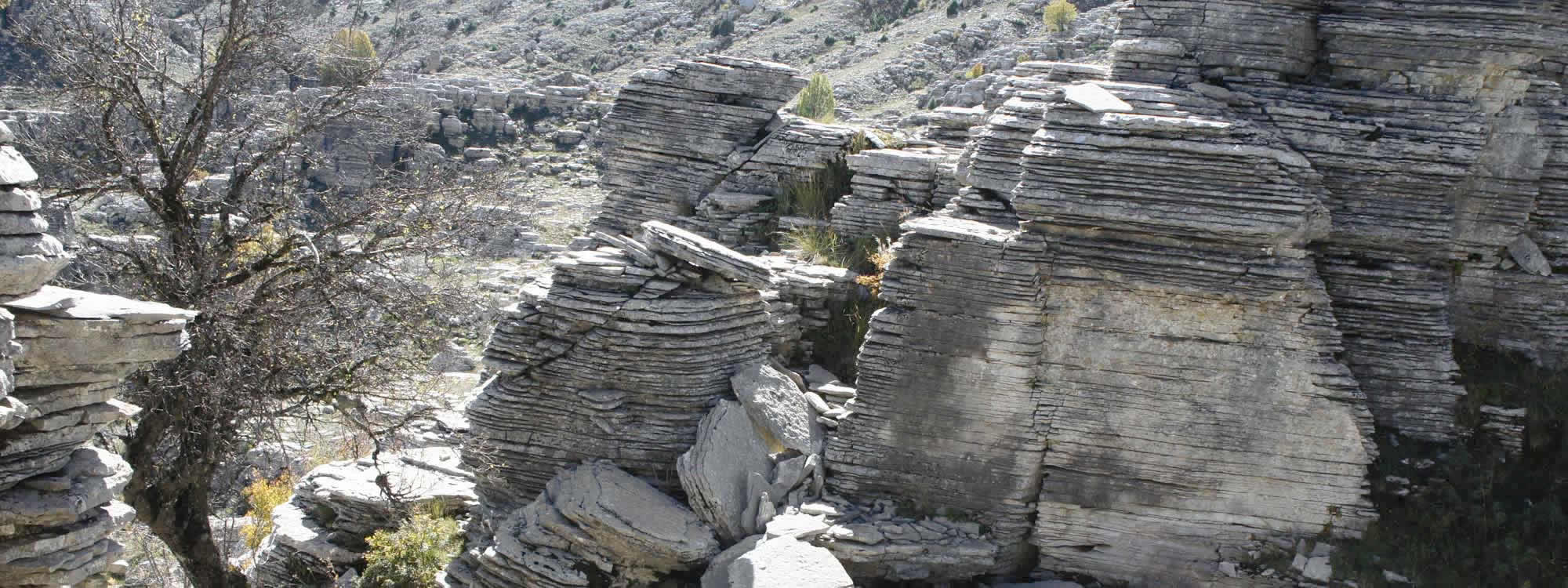Ophiolithic rocks are dominating in the northern and central part of the National Park (Smolikas, Flampouro, Vasilitsa, Tsouka Rossa, Ligkos, Mavrovouni). On the contrary, the southern and western part of the Park (Tymfi, Trapezitsa, Mitsikeli) and some places at the central (Kousta, Koziakas) and northeast (Orliakas) are dominated by limestones.
At October 1st, 2010, the broader area of Vikos-Aoos, because of its high geologic and geomorphologic value, was characterized as “Vikos-Aoos Geopark” and was included at the UNESCO European Geoparks Network. It is now the 4th recognized Geopark of Greece-the other three are the Lesvos Petrified Forest, Chelmos-Vouraikos and Psiloritis. Vikos-Aoos Geopark includes Tymfi mountain chain, Vikos and Voidomatis canyon, Aoos canyon, Trapezitsa Mountain, Smolikas and Kleftis, the area where rivers Aoos, Voidomatis and Saranataporos unite, Kavasila and Amarantos hot springs. The biggest part of the Geopark is included in the borders of the Northern Pindos National Park.
The purpose for the founding of the Geopark, is the designation, exposure and protection of the Geopark as a geologic monument of nature in parallel with the designation of the natural and human environment of the area. Also, a goal is for the Geopark to become an adding purpose for visitors to come and explore the rare and unique geologic and geomorphologic monuments of Vikos-Aoos Geopark.
A Short Geologic View of Valia Kalda
The mountains of Valia Kalda are made of a kind of rock called peridotite. Peridotites form within the earth’s mantle, at depths nearly 100 km below the earth’s surface. The peridotites of Valia Kalda date from ~170 million years ago, during the geologic period known as the Jurassic. How rocks from so great a depth came to be exposed in our high mountains is one of the geologic wonders of Greece.
170 million years ago … Deep rocks within the earth’s mantle began to rise, and as they did so, some of the minerals within them began to melt, creating magma. The magma reached the surface of the earth as lava, mainly through sub-sea volcanoes in the midst of the old Tethys Ocean. Lava from these subsea volcanoes can be seen in the Pindos Mountains at Perivoli, Mikrolivado and Monahiti.
The rocks that were left behind in the deep earth after the magma was melted from them are peridotites. In some sense, they are the “leftovers” in the earth from the birth of volcanoes. The minerals in the peridotites show us the conditions of temperature and pressure present in the earth’s mantle, that is, the environment deep in the earth. Many of the mantle rocks of Valia Kalda are still “pristine,” they have not changed at all from their birth in the earth’s mantle. The interior of the hard and sharp rocks found at Stavros in Valia Kalda are grey and green colored, a mix of three main minerals: Olivine (grey-green in color), Pyroxene (square in shape and dark), and Chrome Spinel (small grains that are black and usually shiny). Bands and layers of these minerals actually show us the intense stress and deformation they suffered in the mantle. From these features, we can actually reconstruct how tectonic plates move!
The gold and yellow surfaces on the peridotite rocks of Stavros show that they have “rusted” in the oxygen-rich atmosphere of the earth’s surface. But many of the peridotites were penetrated by water when they were rising to the earth’s surface; these waters caused the alteration of the fresh minerals of olivine and pyroxene to minerals of the serpentine family. Rocks containing these altered minerals are known as “serpentinites.” Serpentinites are usually black or dark green, are brittle but easily broken, and some even show coats of grey, green or even blue secondary minerals (listwanites). Many of the peridotites of Valia Kalda contain some serpentine and some have become entirely altered to serpentine.
The peridotites, lavas, and deep sea sediments that formed within and below the ancient Tethyan Sea of the Jurassic were “trapped” between the tectonic plates of Africa and Europe as these to continents drifted towards each other, and finally collided. The entire Tethys was destroyed in this collision by about 50 million years ago. But small fragments of the Tethys are pushed up onto the continent of Europe, and these fragments include the peridotites of Valia Kalda. If we hadn’t found these old Jurassic oceanic rocks, we wouldn’t have evidence for the existence of the Tethyan Ocean.
Even after the destruction of the Tethyan Sea, even after the remnants of the oceanic rocks had reached the earth’s surface, the tectonic plates of Africa and Europe kept pushing against each other. This pushing finally shoved the rocks of Valia Kalda over rocks of a much younger age. These younger rocks are sediments that were eroded from the European Continent through streams and rivers, and deposited in a great delta, much like that formed from the deposits of the Mississippi River into the Gulf of Mexico today. These sediments, hardened into a rock type called “flysch,” are relatively soft, yellow-grey in color, and mainly composed of sands, gravels, and clays. The rocks of the flysch occur in layers, each layer corresponding to a flood of sediments coming from the old European continent.
All the rocks of Valia Kalda – the peridotites, the serpentinites, the oceanic sediments and flysch – were then witness to the Ice Ages of the Pleistocene. The mountain tops surrounding Valia Kalda are carved to sharp edges by glaciers. Avgo Peak itself is a glacial feature called a “horn,” sculpted by ice on all sides such as the Matterhorn of Switzerland. The “Dragon Lakes” are features call glacial tarns, the melting spots of the last ice of the glaciers. Piles of rocky debris left from the glaciers can be seen within Valia Kalda.
The Valia Kalda environment is the result of 170 million years of a complex, unique geologic history. The presence of such rare rocks as peridotite is the basis of a very rare ecosystem. The isolation of Valia Kalda has protected the ecosystem during most recent history. The Forestry Service of Greece and now the North Pindos National Park are working to protect this rare environment: without the appropriate management, this internationally unique ecosystem could be altered in very short time.
When we sit under the shadow of a sycamore tree –a form of life that has changed slightly from the era of the dinosaurs – we share at least 100 million years of Earth History. Within Valia Kalda, we share the processes of plate tectonics that formed the entire world of Greece.
Dr. Annie Ewing Rassios,
Geologist, Institute of Geology and Mineral Exploration





